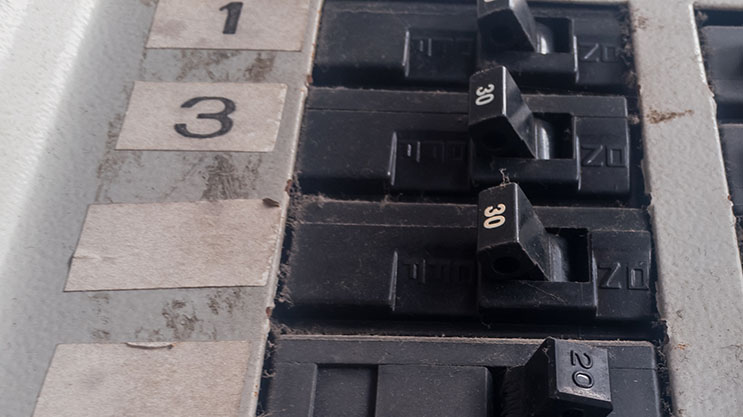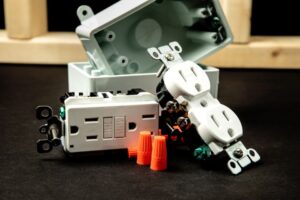Have you ever had a circuit breaker trip and found that it won’t reset? It’s a common problem, and one that can be frustrating when you’re not sure what to do.
The most common reasons for a circuit breakers that won’t reset are:
- Damaged breakers
- Electrical shorts
- Loose wiring
- Corrosion
- Damaged insulation
In this post, we’ll walk you through how to check for each of these common reasons, and discuss how to fix them.
Why circuit breakers trip
A circuit breaker is a safety device in your home designed to stop the flow of electricity if there’s an overload, which can help prevent fires. When the current flowing through the circuit breaker becomes too much for it to handle, it “trips” and shuts off the power to prevent a fire from starting.
Most of the time, resetting a tripped circuit breaker is a simple matter of flipping the switch back to the “on” position. However, sometimes the breaker won’t reset no matter how many times you flip it.
First, try to reset the tripped circuit breaker
First, we should perform a basic test to make sure the breaker is actually malfunctioning. If you haven’t already tried manually resetting the circuit breaker, this is the place to start.
Locate your circuit breaker box and open the cover. Once you’ve located the tripped breaker, flip it to the “Off” position. Then, flip it back to the “On” position. You should hear a click as the breaker resets. If the breaker trips again, or simply won’t reset, there may be a problem with your wiring.
How to fix a tripping circuit breaker
Check to see if the circuit breaker is damaged
If the circuit breaker trips and won’t reset, the first thing you should do is check to see if the switch is damaged. Circuit breakers are designed to trip when they become overloaded, which means they’re also designed to be flipped back on when the overload is resolved. However, if the switch itself is damaged or the electrical panel is outdated, it may not reset properly.
To check for damage, first make sure that there’s no power going to the breaker box by flipping all the switches to the “off” position. Then open up the panel and visually inspect the faulty breaker for any signs of burned or blackened areas. If you see any charring or burning around the switch, it’s likely time to replace it.
In some cases, you may be able to reset a damaged breaker by gently bending the switch back into place. However, this is only a temporary fix and the breaker will eventually need to be replaced.
We recommend that if you see any damage, it’s best to replace the entire circuit breaker rather than just the switch.
Check to see if there’s an electrical short
Another reason why your circuit breaker won’t reset after tripping is because there’s an electrical short somewhere in your home. An electrical short occurs when there’s too much current flowing through a wire, causing it to overheat and potentially start a fire.
To figure out if there’s an electrical short, the first thing you should do is turn off all of the switches in your breaker box. Once everything is off, go around your home and look for any signs of an electrical fire, such as burning smells or smoke. If you see or smell anything suspicious, call a licensed electrician right away.
If you don’t see any signs of a fire, the next step is to identify which circuit is causing the problem. Start by flipping on one switch at a time and seeing if the breaker trips. If it does, leave that switch off and move on to the next one. Repeat this process until you’ve found the problem circuit.
Once you’ve identified the problem circuit, the next step is to figure out where the electrical short is located. The easiest way to do this is to start at the breaker box and work your way down the circuit until you find the problem.
If you’ve followed these steps and you believe there may be an electrical short, it’s important to call an electrician right away. They’ll be able to locate the source of the problem and fix it before it causes any further damage.
Check for loose wiring
Another common reason for a circuit breaker to trip is because of loose wiring. Over time, wires can loosen and become frayed, which can cause them to short circuit.
The best way to check for loose wiring is to listen to your devices and appliances for the sound of buzzing or crackling. One common culprit is buzzing light switches or outlets. If you don’t find a faulty appliance, note that this can also be true around the breaker.
If you hear these noises and suspect that your circuit breaker is tripping because of loose wiring, the best thing to do is call an electrician as soon as possible. Trying to fix the problem yourself could result in injury or even death.
An electrician will be able to quickly diagnose the problem and make the necessary repairs. In most cases, they’ll also be able to prevent the problem from happening again in the future.
Look for signs of corrosion
Another common reason for a circuit breaker to trip is corrosion. This is especially true if you notice any moisture or wetness in the electrical panel. Corrosion can cause the metal parts of the breaker to break down, which in turn can cause a short circuit.
Corrosion usually appears in the form of a white, chalky substance building up around screw terminals. Look for signs of corrosion, rust, or moisture around the circuit breaker.
If you suspect that corrosion is the culprit, call an electrician to have a look at the problem. Trying to clean or repair the corrosion yourself could result in serious injury.
Check for damaged insulation
Sometimes circuit breakers will have insulation around them to stop cold air from entering through the box itself. Damaged insulation is another common cause of tripped circuit breakers. If you have insulation around the box, inspect it to see if it looks damaged.
If the insulation around your electrical wiring is damaged, it could cause a short circuit. Once again, if you suspect that this is the problem, call an electrician rather than trying to repair the problem yourself.
Is it dangerous if a circuit breaker keeps tripping?
We are often asked if tripping circuit breakers are dangerous. If your circuit breaker keeps tripping, it could be a sign of an electrical problem in your home, up to and including serious fire risks. While it’s not necessarily dangerous if your circuit breaker trips occasionally, if it happens frequently, it should be fixed right away.
Conclusion
If your circuit breaker trips and won’t reset, don’t panic! Many times the problem is something minor that you can easily fix yourself. However, if you’re unsure of what to do or think the problem may be something more serious, always err on the side of caution and call an electrician. Trying to fix the problem yourself could result in serious injury or even death.
Resetting a tripped circuit breaker is a relatively simple process that most people can do on their own. However, if the breaker trips repeatedly or if you have any questions about your electrical system, it’s always best to contact a professional electrician for assistance.
If you have any questions about resetting your circuit breaker or if you need assistance from a professional, don’t hesitate to contact us. We’re here to help!









